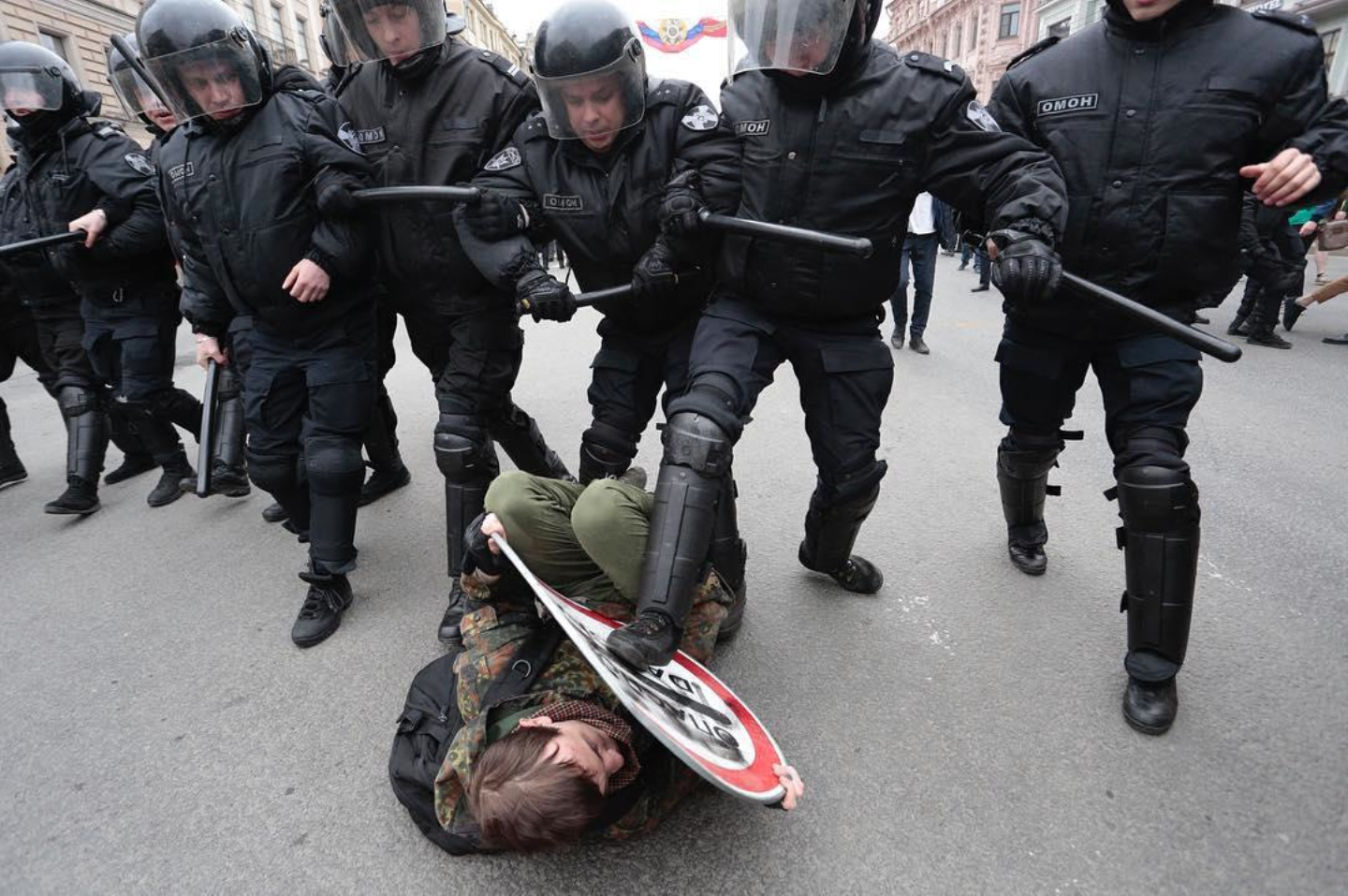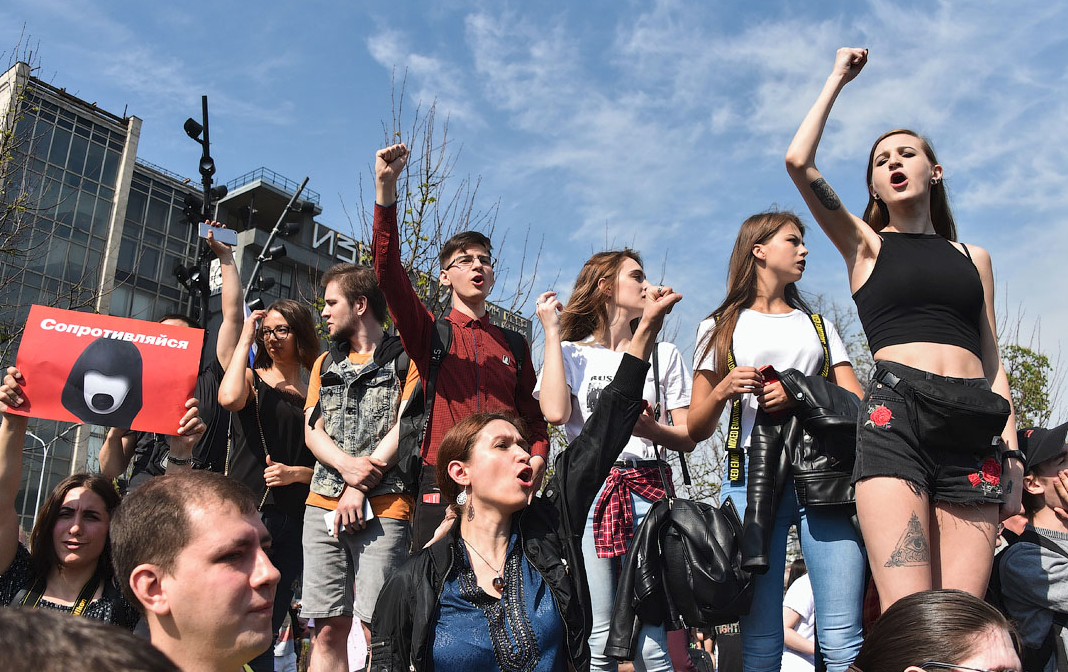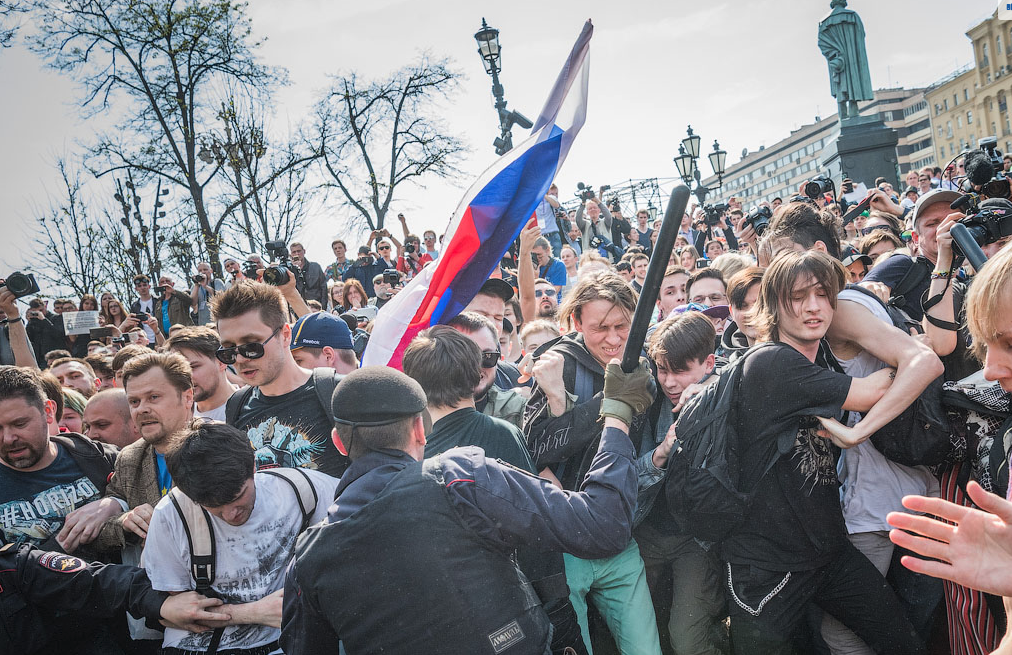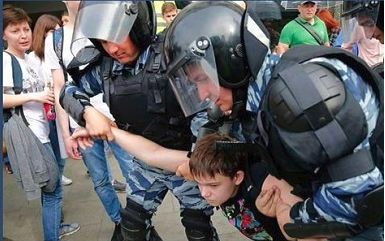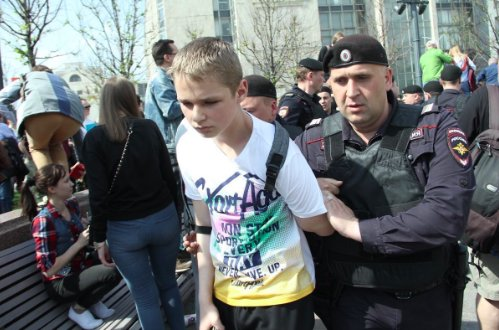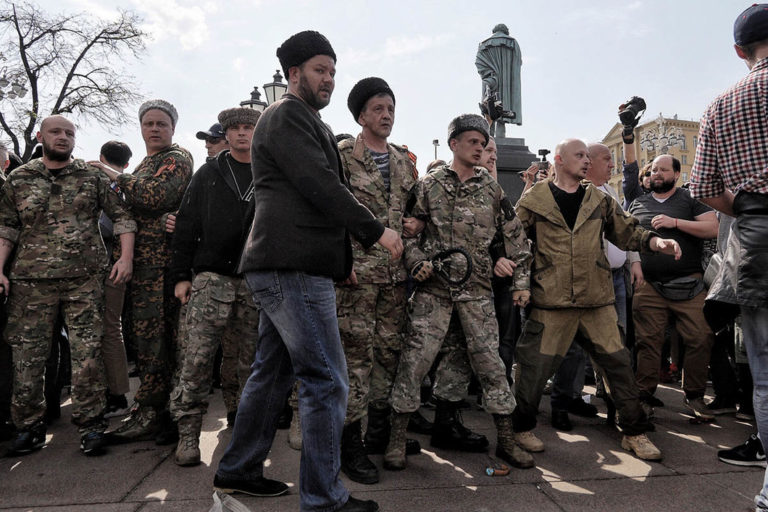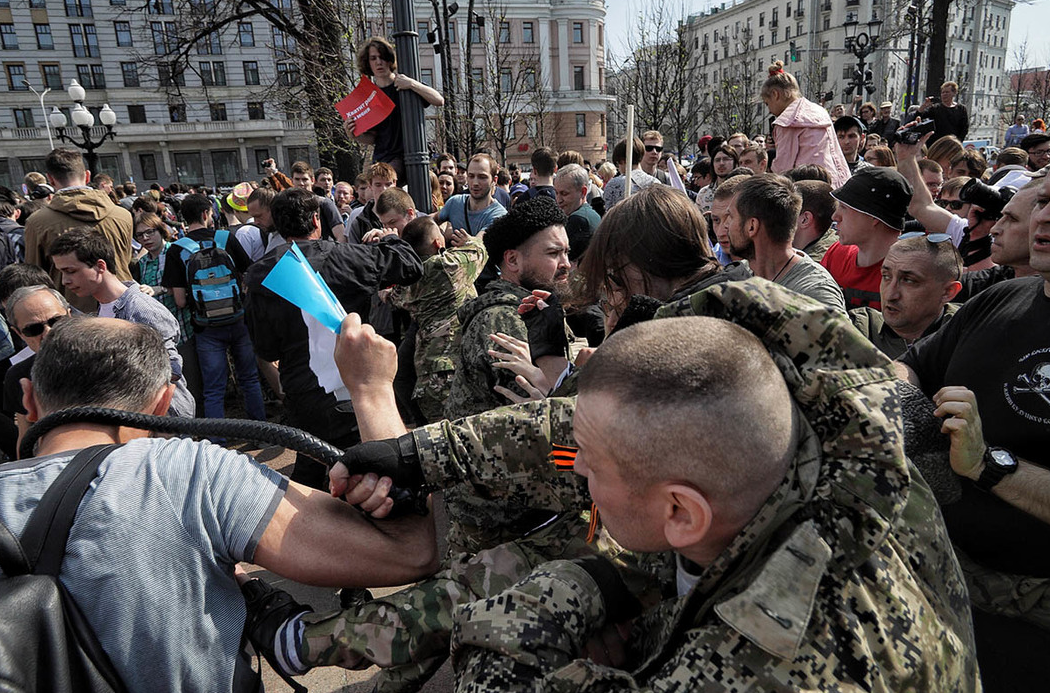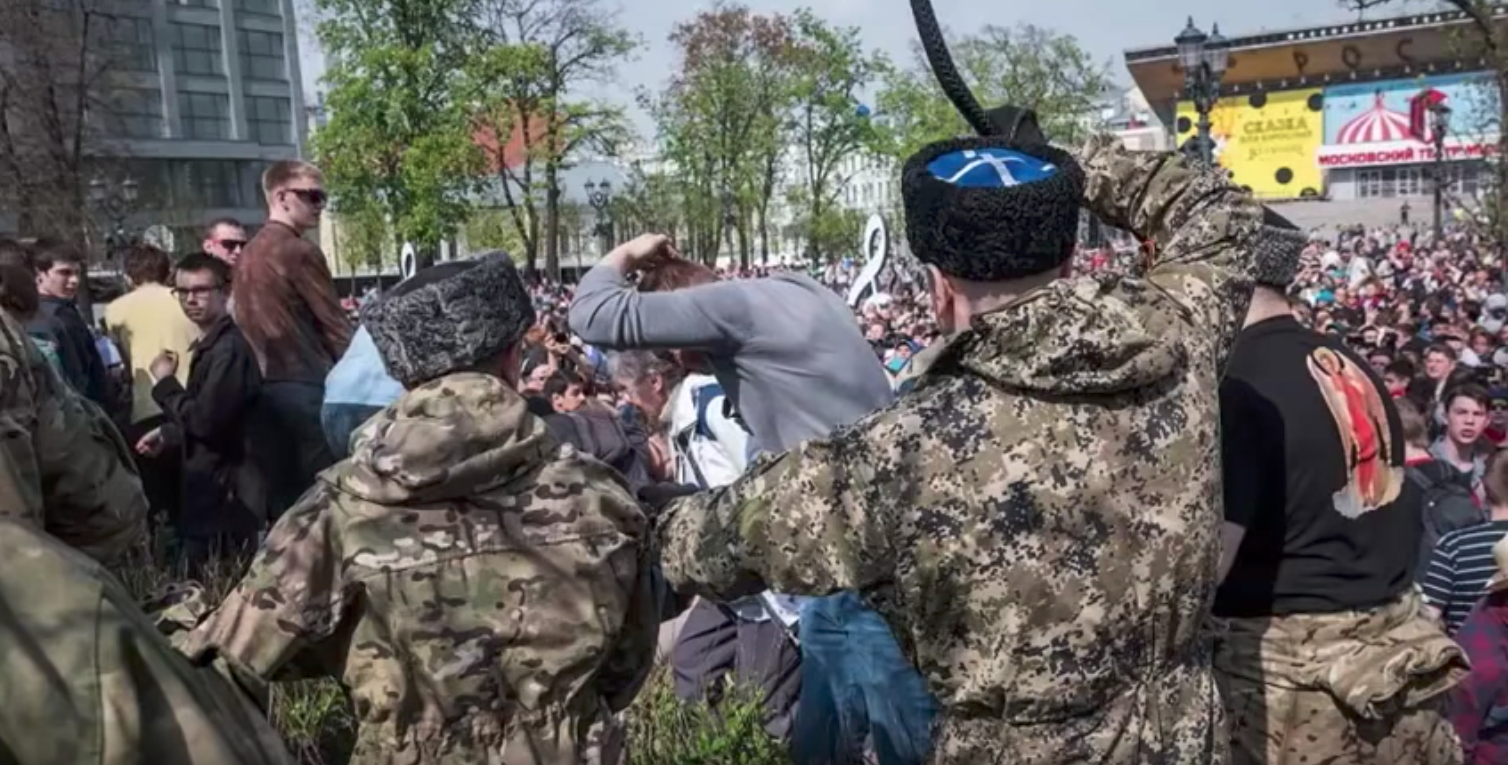The Fourth inauguration of Vladimir Putin as the President of Russia took place on Monday, May 7, 2018. The comment of the New York Times on the event was entitled: “For Putin’s 4th Term, More a Coronation Than an Inauguration.”
Russian opposition to Putin was reported upon by the New York Times. On May 5, two days prior to the inauguration, a protest action called “He is not our czar” took place all over Russia, by the initiative of Alexei Navalny. Demonstrators wore paper crowns to mock Mr. Putin’s long rule, now running longer than any Russian leader since Stalin.
As well as in the previous protest demonstrations in recent time, there were a lot of very young people among the demonstrators.
On May 5th, the police was especially violent to demonstrators, disregarding their age. 703 people have been arrested in Moscow and about 1,600 throughout Russia.
What was especially stressed in the reports of Russian anti-Putin media and Internet: the violence included a throwback to an earlier (tsarist) era of crowd-control tactics in Russia. Men wearing Cossack uniforms and carrying a type of traditional leather whips known as nagaikas had mingled in the crowd, occasionally lashing out.
Cossacks are members of self-governing, semi-military communities, predominantly located in Southern Russia and in South-Eastern Ukraine.
By the end of the 18th century Cossack settlements had been transformed into a special military estate, “a military class”. Because of their military tradition, Cossack forces played an important role in Russia’s wars of the 18th–20th centuries.
Cossack settlements formed military units and regiments of light cavalry or mounted infantry. They could respond to a threat on a very short notice. Tsar’s government often used Cossacks in actions not only against the ”outside enemies” but also against so called “inside enemies”: all kind of protesters, students, Jews.
A nagaika is a short, thick whip with round cross-section. It is made out of leather strips by braiding. Usually there is a piece of metal at the tip of the whip.
The main purpose of nagaika was to urge a horse. At the same time nagaika was used against unarmed people, mostly to disperse public disorders so that a Cossack with a nagaika has become a symbol of tsarist oppression.
Wikipedia informs: “During the Perestroika era of the Soviet Union of the late 1980s, many descendants of the Cossacks became enthusiastic about reviving their national traditions. In 1988 the Soviet Union passed a law, which allowed formation of former hosts and the creation of new ones. Simultaneously, many attempts were made to increase the Cossack impact on Russian society and throughout the 1990s many regional authorities agreed to hand over some local administration and policing duties to the Cossacks.
“According to 2002 Russia’s population census, there are 140,028 people who currently self-identify as ethnic Cossacks, while at the same time, between 3.5 and 5 million people associate themselves with the Cossack identity in post-Soviet Russia and around the world.”
In 2005, the Cossacks were officially armed with nagaikas in addition to other traditional weapons.
On May 5, in Moscow nagaikas were working as hard as in the time of Tsars.
On May 7, the radio station Echo of Moscow reported that a Cossack group had won municipal contracts to train for and help with crowd control. During the following week several websites presented proofs of the financing.
The Moscow City Hall has been teaching Cossacks to disperse rallies for three years, using budgetary money for that purpose. And the particularly distinguished graduates were even awarded with souvenir nagaikas.
Since 2016, the City Hall’s Department of National Policy and Interregional Relations contracted with the Moscow Central Cossack Society for the training of members of the Cossack communities of Moscow. District Cossack Society received grants “for training and receiving necessary knowledge and skills in carrying out activities to protect public order, public security and mass events on the territory of the city of Moscow.”
The cost of each contract was 5.3 million rubles (about $85,000), totaling nearly 16 million rubles ($250,000) in three years. What had the training included?
There were three stages of training per year, 100 people took part in each stage. The training took place in the sports center of the village of Kuzenevo, 37 km south of Moscow. Cossack-vigilantes, for example, were taught to drag troublemakers correctly: four Cossacks should hold hands and legs of a troublemaker. They were even taught how to properly shoot troublemakers.
The behavior of the police and Cossacks on May 5th triggered protests from many Russians, including even some supporters of Putin.
Maxim Shevhenko, a journalist known to be loyal to Putin and a human rights activist, demonstratively left HRS (Human Rights Council under the President of the Russian Federation), an active member of which he was for many years.
Shevchenko declared:
“The public beating and the massive brutal arrests of non-violent civil protesters throughout Russia and the lack of a coherent and adequate response to these events have become the last drop for me, beyond which membership in the HRC becomes impossible.
“My request to hold an emergency open meeting of the Council with the invitation of representatives of the Government of Moscow, Rosgvardia, the Ministry of Internal Affairs, so-called ‘Cossacks’, the injured participants of the protest actions and journalists was supported by the majority of the members of the HRC. But it was ignored by the governmental offices.
“I thank all my colleagues for their joint work and I want to say that I respect their current civil position, despite differences in our attitude towards the history of Russia in the 20th century.
“But I do not want to take part in the performance mocking human rights, and I will not do that.”
Vladimir Pozner, the most known Russian TV personality, the former President of the TV Academy, who left HRC earlier, reacted to the Shevchenko action:
“I’ve just heard about the resignation of Maxim Shevchenko from the HRC. I want to express to him my support and understanding.
“I finally realized that, to my deep regret, the HRC is not only not an independent organization (obviously, since it is ‘under the President of the Russian Federation’), but it has no real influence and is purely decorative. And realizing this, I left this team. I did it without slamming doors and statements unlike my colleague Maxim Shevchenko, I simply went out – forever.
“Obviously, Maxim Shevchenko suffered the same disappointment as in my time befell me. But he said this at the top of his voice, which makes me feel sincere respect”.
The well known controversial and openly anti-Putin Russian journalist
Alexander Nevzorov gave the most dramatic comment of the event:
“Well, now everything will go according to a well-known scenario, which has been played many times. The children who were screwed and beaten will hate the regime. They will infect their friends and acquaintances with their hatred. Roughly speaking, each of these children has a social circle. These circles, of course, are small. But there are already a lot of beaten and humiliated. These circles, circles of hatred, will merge. They will merge and grow larger, and these larger circles will also merge. And then the real big hatred will be created, hatred, which will be stronger than any submission, hatred, which will be strongest power around.
“I understand that we live in an extraordinary time, the time when any attentive person can see the origin of revolution.”

